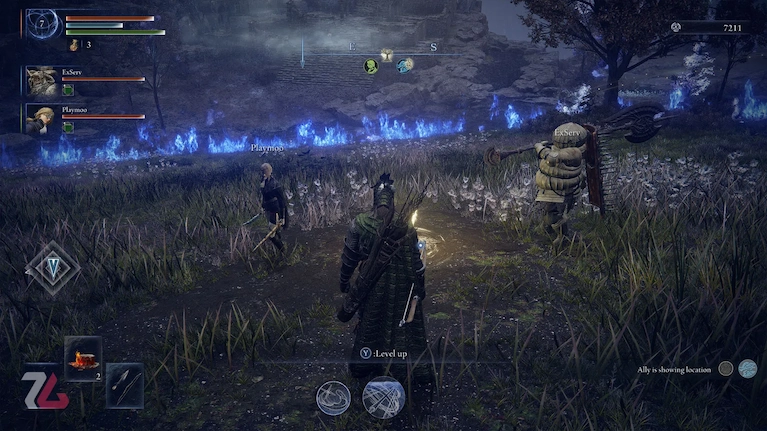Elden Ring is a name that needs no introduction in the gaming world. When it launched in 2022, it satisfied hardcore FromSoftware fans and even won over players like myself—who weren’t previously sold on the Souls genre. Its success continued with a well-received DLC, and now, Elden Ring has grown into a fully-fledged franchise. The latest spin-off, Elden Ring: Nightreign, is a bold new take on the formula—and with an upcoming movie adaptation confirmed, it’s clear that FromSoftware is going all-in on this universe.
But how connected is Nightreign to the original Elden Ring? And can a multiplayer-focused Soulslike truly capture the magic of the original?
Nightreign’s Opening: Familiar, Yet Foreshadowing Change
Nightreign begins like many FromSoftware titles: a harsh, cryptic world where you’re reminded that brute force won’t get you far. The game kicks off at the iconic Roundtable Hold, setting the stage for a quest to defeat the Night Lords and bring peace to a shattered realm.
The adventure unfolds in a world called Limveld, which changes slightly with every run. Though the environment stays familiar, key elements on the map shift, bringing a roguelike twist to exploration. And if you’re unfamiliar with roguelikes, that’s your first clue: Nightreign is not your traditional Soulsborne.
Gameplay Structure: A Roguelike Reimagining of the Elden Ring World
In Nightreign, you choose from eight character classes and dive into the world either solo or with up to two teammates. Each session spans three days:
- Days 1 & 2: You explore, level up, and gather gear during the daytime, while at night, a shrinking circle (à la battle royale games) forces you toward a final boss area.
- Day 3: You face off against the main Night Lord in a final, brutal battle.
This loop drastically changes the pacing compared to Elden Ring. Instead of methodical exploration, you’re forced to rush through enemies, collect Runes, and prepare for an end-of-day boss fight that will destroy you if you’re under-leveled or under-prepared.
Time Pressure Kills the Exploration Joy
For players like me, what made Elden Ring special was its open-ended freedom—the thrill of uncovering secrets, hidden zones, and story fragments scattered across the map. Nightreign strips that away.
The time-limited structure means if you waste time exploring like in a traditional Souls game, you’ll be underpowered by nightfall. And the Night Lords don’t play fair: even veteran players can be taken down in two hits if they aren’t ready.
Most players end up rushing through early mobs to farm Runes from mini-bosses, many of which are reworked versions of familiar foes from the original game—except now you don’t have the luxury of learning their patterns slowly. It’s fast or fail.
A Matter of Taste: Will You Love or Hate Nightreign?
While I don’t believe in dismissing games based on genre, Nightreign is very much a style-first experience. If you come expecting a slow, lore-rich, atmospheric journey, this isn’t it. But if you’re into fast-paced, high-stakes combat with light exploration, you might fall in love.
Narrative Approach: Light World-Building, Strong Side Stories
There is a main story arc, gradually revealed as you defeat Night Lords, but it’s average at best. However, side characters have surprisingly compelling backstories, revealed through journal entries and optional quests. These moments offer thoughtful bits of lore, even if the main plot lacks the emotional depth of Elden Ring.
Solo vs. Co-op: A Game Meant to Be Shared
Here’s the truth: Nightreign is not ideal for solo play.
Some classes, like the ranged Iron-Eye archer, shine in co-op thanks to their ability to revive teammates from a distance. Alone, however, they struggle against multiple enemies and late-game bosses. The same goes for magic-based classes.
In co-op, team coordination becomes essential. Boss fights feel more balanced and rewarding, and when done right, the teamwork delivers an epic, memorable experience. I found myself wanting to hug my teammates through the screen after one particularly intense Night Lord victory.
Unfortunately, voice chat is missing, which limits in-game communication and emotional expression—a missed opportunity in such a team-focused experience.
Permadeath Mechanics and Limited Healing in Solo Mode
In solo mode, you can’t be revived. Die during the day, and you lose Runes and a level. Die at night—or against the final boss—and it’s game over. You can buy a one-time revive item, but it’s not a real replacement for teammates.
A simple AI companion system like in parts of Elden Ring would’ve made solo play more enjoyable and accessible.
Progression System: Simplified and Smart
Nightreign ditches intricate stat distribution in favor of a class-based level-up system, which makes sense in a roguelike setting. After every run, your character resets, but you retain Relics, powerful items that enhance future playthroughs. Relic synergy is key to success, and their variety allows for some interesting builds and replay value.
Visuals and Sound: Familiar, Yet Refined
Nightreign reuses many visual and audio assets from Elden Ring, but they’re reassembled with care. The world, enemies, and environments feel polished, and the new character voice acting is top-notch. The soundtrack, as expected from FromSoftware, is atmospheric and perfectly timed.
Final Verdict: Nightreign Isn’t Elden Ring – But That’s Okay
Elden Ring: Nightreign is a bold experiment. It’s not Elden Ring 2, nor does it try to be. Instead, it delivers an addictive, fast-paced roguelike with high-stakes battles and strong co-op elements.
If you loved Elden Ring for its vast world and deep narrative, this might feel like a step back. But if you enjoy hardcore boss fights, procedural loops, and team-based challenges, Nightreign is a worthy addition to the franchise.
